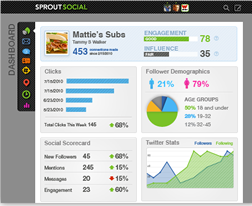 Social Media Marketing has taken a firmer position within the marketing mix of most companies in one way or another. For some, social web participation is a natural fit. For many others, being more social isn’t in the management DNA. Regardless, marketers are held accountable for improving the bottom line and with that comes a number of common “headaches”.
Social Media Marketing has taken a firmer position within the marketing mix of most companies in one way or another. For some, social web participation is a natural fit. For many others, being more social isn’t in the management DNA. Regardless, marketers are held accountable for improving the bottom line and with that comes a number of common “headaches”.
Yesterday I did a webinar with a client of ours, NewsUSA, on social media headaches. As part of the prep for that, I wrote out answers to some of the questions and thought it would be of interest to our Online Marketing Blog readers as well.
Getting Approval From the C-Suite
What is the most important piece of information you need to get approval for a social media campaign?
 The simple answer is to make sure you tie what you’re doing to revenue growth, customer acquisition and retention, increased profitability or some other top level business goal.
The simple answer is to make sure you tie what you’re doing to revenue growth, customer acquisition and retention, increased profitability or some other top level business goal.
Many companies approach social media marketing as a series of disconnected campaigns without coordination, overall strategy or specific outcomes defined. It’s no wonder that many of those efforts fail to deliver expected results.
Getting management approval starts with answering some key questions. First, the reason for a campaign must be clear: What business goals are you trying to achieve? Where does the individual campaign effort fall within the overall social media strategy? How could it directly or indirectly affect business goals? What resources or investment need to be made and what can you reasonably project as an outcome? (short and long term)
Start with a hypothesis and develop a plan for reaching or influencing business outcomes. Show KPI (key performance indicator) measurements and to what degree they can correlate with goals such as increased leads, increased quality of leads, reduced sales cycle, increased blogger and media mentions, increased candidate inquiries, lower customer support costs, etc. When it’s new territory, business executives may be more likely to approve if you can show a path from where you are now towards influencing business outcomes.
Social Content Creation
What’s your favorite time saving shortcut with content?
 Planning. Creating an editorial plan can save a lot of time with content creation. Obviously, a business needs writing resources internally or outsourced to help author and repurpose content, but creating a topical plan for writing articles, blog posts and media in the way an Editorial Calendar is created for a publication, can save a lot of time. Specific types of content with due dates keeps content creation and promotion on track and efficient.
Planning. Creating an editorial plan can save a lot of time with content creation. Obviously, a business needs writing resources internally or outsourced to help author and repurpose content, but creating a topical plan for writing articles, blog posts and media in the way an Editorial Calendar is created for a publication, can save a lot of time. Specific types of content with due dates keeps content creation and promotion on track and efficient.
Another time saver is to use content-type templates. As a content marketer for all of our 10 years in business, I’ve found certain formats of articles or blog posts and even social content to work better than others. Develop content formats or templates as well as libraries of keywords, hooks & clever angles that support key messages and desired reader behaviors can save quite a bit of time when you’re after a quantity of quality content.
The thing about saving time is that quality must be maintained. Getting 3 articles out in the time it takes to do one doesn’t mean anything if the 3 are crap.
A third time saver is to leverage other people in your organization, especially subject matter experts, sales people and customer service staff. People who interact with customers and prospects answering questions are a goldmine for quality content ideas.
Finding/Reaching Your Audience
What networks reach the audiences best?
 The key is to find “your” audience. To do that it’s important to construct ideal customer profiles or personas. Collect information that exemplifies your best customers and discover their information discovery, consumption and sharing preferences. What topics are they interested in? What are their pain points? What do they search for? What do they talk about on social media sites? Where do they hang out and who / what influences them?
The key is to find “your” audience. To do that it’s important to construct ideal customer profiles or personas. Collect information that exemplifies your best customers and discover their information discovery, consumption and sharing preferences. What topics are they interested in? What are their pain points? What do they search for? What do they talk about on social media sites? Where do they hang out and who / what influences them?
That buyer persona can then guide your content plan as well as your social media research and listening efforts to uncover which social media and network sites to engage with.
Part of this process can involve taking a prospect newsletter email list and leveraging it with a service like Rapleaf or Flowtown. Importing email addresses into those services will reveal wherever those individuals have registered accounts on social media sites.
Along with social monitoring software that shows where key topics are being discussed on the social web, a marketer can use a social profile appending servives to see which social networks and media sites their prospects are connected to.
Imagine finding out that your list shows 85% visibility on Facebook and 35% on LinkedIn when you thought the reverse?
Ultimately, the best networks are those that provide a platform for customers to find what they looking for and for brands to be useful to and engage those customers.
Presenting Results to the C-Suite
How do you keep reporting simple and easy to understand?
 Dashboards are popular and many social media management services have popped up to help manage social media assets, promotions and success metrics. Those that integrate with web analytics are especially helpful.
Dashboards are popular and many social media management services have popped up to help manage social media assets, promotions and success metrics. Those that integrate with web analytics are especially helpful.
Unfortunately, executive level social media reporting to the C-Suite is still a bit of a challenge because they most often care about the direct impact on business growth – something that is difficult to measure with social media efforts due to the indirect influence and delayed effect. However, correlation measures can be offered, such as an overlay of the progression of social media KPIs on top of business goals.
For example:
- An increase in the community connections and measures of engagement actions that correspond to a decrease in customer service call center costs.
- The increase trend in social content creation and citations from the community overlaid with an increase in non-campaign new prospect inquiries.
The key with C-Suite reporting is to properly manage expectations, keep it simple and do your best to focus on both the direct and indirect impact of social media efforts on overall business goals.
What have some of your biggest headaches been with social media and management?


